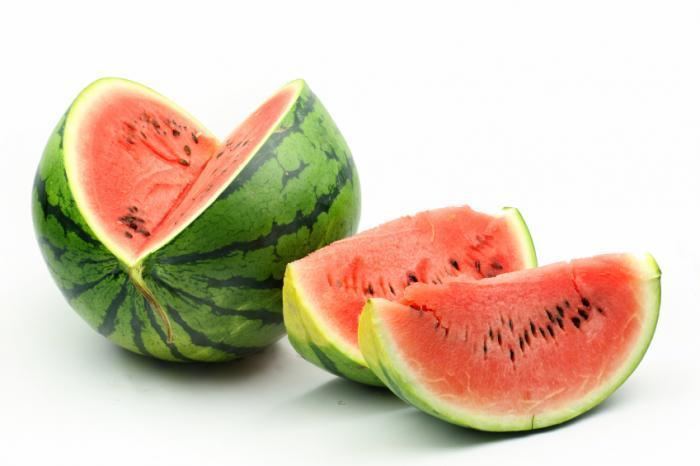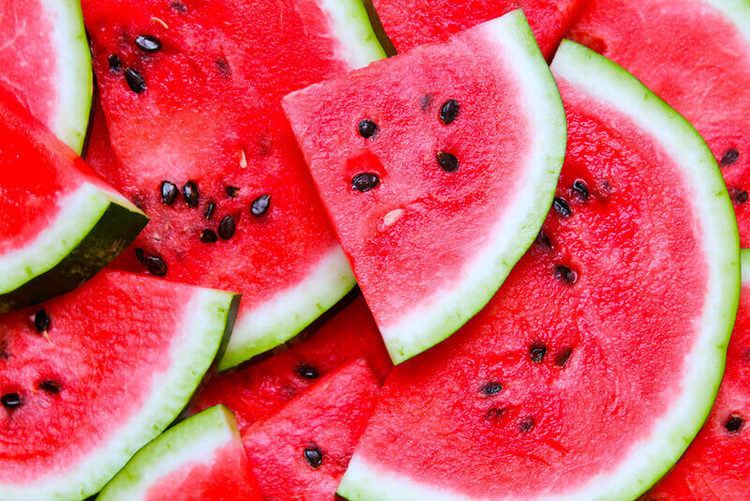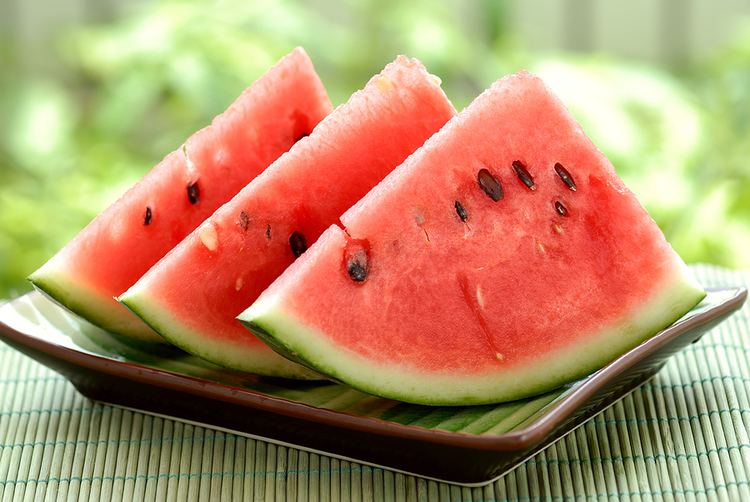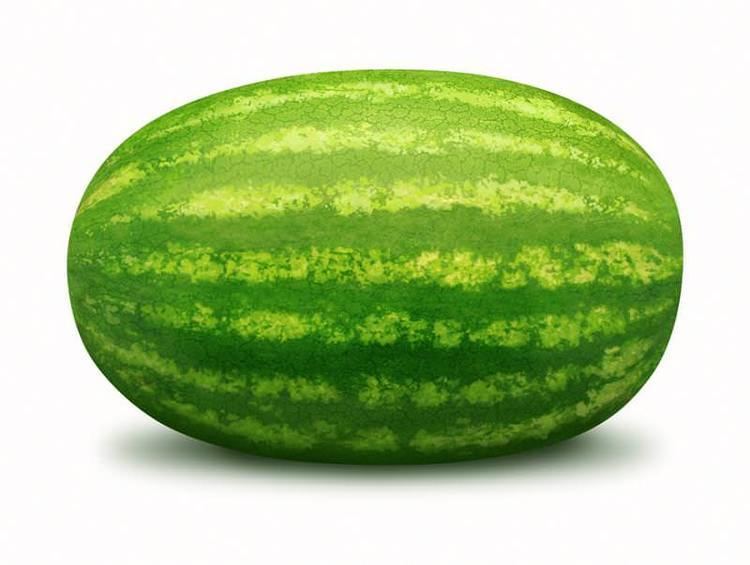Kingdom Plantae Species C. lanatus | Variety lanatus | |
 | ||
Similar Muskmelon, Melon, Pineapple, Fruit, Strawberry | ||
9 original ways to cut a watermelon
Watermelon (Citrullus lanatus var. lanatus, family Cucurbitaceae) is a scrambling and trailing vine originally from southern Africa. It is a large, sprawling annual plant with coarse, hairy pinnately-lobed leaves and white to yellow flowers. It is grown for its large edible fruit, also known as a watermelon, which is a special kind of berry with a hard rind and no internal division, botanically called a pepo. The fruit has a smooth hard rind—usually green with dark green stripes or yellow spots—and a sweet, juicy interior flesh—usually deep red to pink, but sometimes orange, yellow, or white—with many seeds, which can be soft and white or hard and black.
Contents
- 9 original ways to cut a watermelon
- Facts
- Watermelon fruit rhyme
- History
- Description
- Variety improvement
- Cultivation
- Varieties
- Production
- Nutrients
- Food
- References

Considerable breeding effort has been put into disease-resistant varieties and into developing a "seedless" strain with only digestible white seeds. Many cultivars are available that produce mature fruit within 100 days of planting the crop. The fruit can be eaten raw or pickled and the rind can be cooked.
Facts

Watermelon fruit rhyme
History

The watermelon is a flowering plant thought to have originated in southern Africa, where it is found growing wild. It reaches maximum genetic diversity there, with sweet, bland and bitter forms. In the 19th century, Alphonse de Candolle considered the watermelon to be indigenous to tropical Africa. Citrullus colocynthis is often considered to be a wild ancestor of the watermelon and is now found native in north and west Africa. However, it has been suggested on the basis of chloroplast DNA investigations that the cultivated and wild watermelon diverged independently from a common ancestor, possibly C. ecirrhosus from Namibia.
Evidence of its cultivation in the Nile Valley has been found from the second millennium BC onward. Watermelon seeds have been found at Twelfth Dynasty sites and in the tomb of Pharaoh Tutankhamun.

In the 7th century watermelons were being cultivated in India, and by the 10th century had reached China, which is today the world's single largest watermelon producer. Moorish invaders introduced the fruit into Europe and there is evidence of it being cultivated in Córdoba in 961 and also in Seville in 1158. It spread northwards through southern Europe, perhaps limited in its advance by summer temperatures being insufficient for good yields. The fruit had begun appearing in European herbals by 1600, and was widely planted in Europe in the 17th century as a minor garden crop.
European colonists and slaves from Africa introduced the watermelon to the New World. Spanish settlers were growing it in Florida in 1576, and it was being grown in Massachusetts by 1629, and by 1650 was being cultivated in Peru, Brazil and Panama, as well as in many British and Dutch colonies. Around the same time, Native Americans were cultivating the crop in the Mississippi valley and Florida. Watermelons were rapidly accepted in Hawaii and other Pacific islands when they were introduced there by explorers such as Captain James Cook.
Description
The watermelon is an annual plant with long, weak, trailing or climbing stems which are five-angled (five-sided) and up to 3 m (10 ft) long. Young growth is densely woolly with yellowish-brown hairs which disappear as the plant ages. The leaves are stemmed and alternate, large and pinnately-lobed; they get stiff and rough when old. The plant has branching tendrils. The flowers grow singly in the leaf axils and the corolla is white or yellow inside and greenish-yellow on the outside. The flowers are unisexual, with male and female flowers occurring on the same plant (monoecious). The male flowers predominate at the beginning of the season; the female flowers, which develop later, have inferior ovaries. The styles are united into a single column. The large fruit is a kind of modified berry called a pepo with a thick rind (exocarp) and fleshy center (mesocarp and endocarp). Wild plants have fruits up to 20 cm (8 in) in diameter, while cultivated varieties may exceed 60 cm (24 in). The rind of the fruit is mid- to dark green and usually mottled or striped, and the flesh, containing numerous pips spread throughout the inside, can be red or pink (most commonly), orange, yellow, green or white.
Variety improvement
Charles Fredric Andrus, a horticulturist at the USDA Vegetable Breeding Laboratory in Charleston, South Carolina, set out to produce a disease-resistant and wilt-resistant watermelon. The result, in 1954, was "that gray melon from Charleston". Its oblong shape and hard rind made it easy to stack and ship. Its adaptability meant it could be grown over a wide geographical area. It produced high yields and was resistant to the most serious watermelon diseases: anthracnose and fusarium wilt. Others were also working on disease-resistant varieties; J. M. Crall at the University of Florida produced "Jubilee" in 1963 and C. V. Hall of Kansas State University produced "Crimson sweet" the following year. These are no longer grown to any great extent, but their lineage has been further developed into hybrid varieties with higher yields, better flesh quality and attractive appearance. Another objective of plant breeders has been the elimination of the seeds which occur scattered throughout the flesh. This has been achieved through the use of triploid varieties, but these are sterile, and the cost of producing the seed by crossing a tetraploid parent with a normal diploid parent is high.
Today, farmers in approximately 44 states in the United States grow watermelon commercially. Georgia, Florida, Texas, California and Arizona are the United States' largest watermelon producers. This now-common fruit is often large enough that groceries often sell half or quarter melons. Some smaller, spherical varieties of watermelon—both red- and yellow-fleshed—are sometimes called "icebox melons". The largest recorded fruit was grown in Tennessee in 2013 and weighed 159 kilograms (351 pounds).
Cultivation
Watermelons are tropical or subtropical plants and need temperatures higher than about 25 °C (77 °F) to thrive. On a garden scale, seeds are usually sown in pots under cover and transplanted into well-drained sandy loam with a pH between 5.5 and 7, and medium levels of nitrogen.
Major pests of the watermelon include aphids, fruit flies and root-knot nematodes. In conditions of high humidity, the plants are prone to plant diseases such as powdery mildew and mosaic virus. Some varieties often grown in Japan and other parts of the Far East are susceptible to fusarium wilt. Grafting such varieties onto disease-resistant rootstocks offers protection.
The US Department of Agriculture recommends using at least one beehive per acre (4,000 m2 per hive) for pollination of conventional, seeded varieties for commercial plantings. Seedless hybrids have sterile pollen. This requires planting pollinizer rows of varieties with viable pollen. Since the supply of viable pollen is reduced and pollination is much more critical in producing the seedless variety, the recommended number of hives per acre (pollinator density) increases to three hives per acre (1,300 m2 per hive). Watermelons have a longer growing period than other melons, and can often take 85 days or more from the time of transplanting for the fruit to mature.
Farmers of the Zentsuji region of Japan found a way to grow cubic watermelons by growing the fruits in metal and glass boxes and making them assume the shape of the receptacle. The cubic shape was originally designed to make the melons easier to stack and store, but cubic watermelons may be triple the price of normal ones, so appeal mainly to wealthy urban consumers. Pyramid-shaped watermelons have also been developed and any polyhedral shape may potentially be used.
Varieties
The more than 1200 cultivars of watermelon range in weight from less than 1 kg to more than 90 kilograms (200 lb); the flesh can be red, pink, orange, yellow or white.
Production
In 2014, global production of watermelons was 111 million tonnes, with China alone accounting for 67% of the total. Secondary producers each with less than 4% of world production included Turkey, Iran, Brazil and Egypt.
Nutrients
In a 100 gram serving, watermelon fruit supplies 30 calories and low amounts of essential nutrients (table). Only vitamin C is present in appreciable content at 10% of the Daily Value (table).
Watermelon fruit is 91% water, contains 6% sugars, and is low in fat (table).
Food
Watermelon rinds are also edible, but most people avoid eating them due to their unappealing flavor. They are used for making pickles, sometimes eaten in the Southern US, and less often as a vegetable, where the rind is stir-fried or stewed.
The amino acid citrulline is produced in watermelon rind. Watermelon pulp contains carotenoids, including lycopene.
The Oklahoma State Senate passed a bill in 2007 declaring watermelon as the official state vegetable, with some controversy about whether it is a vegetable or a fruit.
The seeds have a nutty flavor and can be dried and roasted, or ground into flour. In China, the seeds are esteemed and eaten with other seeds at Chinese New Year celebrations. In Vietnamese culture, watermelon seeds are consumed during the Vietnamese New Year's holiday, Tết, as a snack.
Watermelon juice can be made into wine or blended with other fruit juices. An alcoholic creation called a "hard watermelon" is made by pouring liquor into a hole in the rind of a whole fruit, and then eating the alcohol-permeated flesh.
C. l. lanatus var caffer grows wild in the Kalahari Desert, where it is known as tsamma. The fruits are used by the San people and wild animals for both water and nourishment. Traditionally, travelling in the desert in the dry season could only be done in a good tsamma year. Humans can survive on an exclusive diet of tsamma for six weeks.
